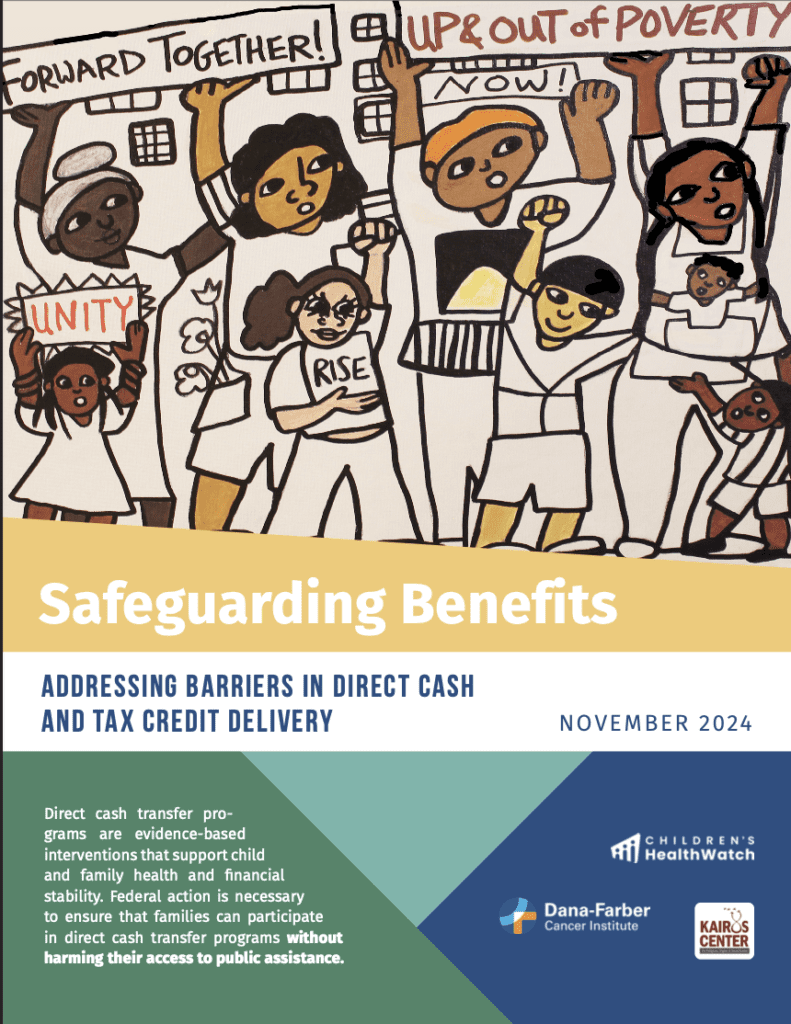
Safeguarding Benefits Addressing Barriers in Direct Cash and Tax Credit Delivery
by Charlotte Bruce, MPH, Kate Scully, JD, Jarvis Benson, MA, Shailly Gupta Barnes, JD, Stephanie Ettinger de Cuba, PhD, MPH, Amrita Yeshi
November 25, 2024
The Kairos Center’s latest policy report with Children’s Health Watch and the Dana-Farber Cancer Institute focuses on barriers to direct cash transfers and tax credits that minimize their impact. These programs were critical for millions of families during the pandemic and can be improved to meet persistent needs for households across the country. While this report calls for a national fix to this issue as the north star, due to changing contexts, we encourage researchers and advocates to continue working at the state level to safeguard access to essential public assistance programs.
Executive Summary
Direct cash transfer programs, including direct cash pilots and refundable family tax credits, are evidence-based interventions that support child and family health and financial stability. These programs are most effective when implemented alongside (and not in place of) other public assistance programs. Federal action is necessary to ensure that families can participate in direct cash transfer programs without harming their access to public assistance.
Direct Cash Transfer Program
There are a wide range of programs that provide families with additional resources in the form of unrestricted cash. For the purposes of this report, we focus on direct cash pilots and refundable family tax credits. We are combining discussion of tax credits with direct cash pilots, also know as guaranteed income pilots, given the similar structure and well-documented impact of a fully refundable Child Tax Credit, especially when distributed to families on a monthly basis. Similar to payments received in direct cash pilots, a monthly tax credit provides families with additional, regular income alongside other public assistance programs, supporting family choice and autonomy.
Introduction
Currently in the United States, 64% of the population lives paycheck to paycheck and 11.1% lives below the poverty line. Without adequate cash, families are unable to afford the stability that children need to thrive. However, programs and policies that provide families with unrestricted cash – including direct cash pilots and refundable tax credits – have received growing public support and demonstrated a large-scale policy opportunity to advance equity and improve health and stability for children and families.
In 2021, we saw a direct cash transfer for families with children on a national scale when the federal government dramatically expanded the Child Tax Credit in response to financial uncertainty caused by the COVID-19 pandemic. The expanded credit of up to $300 a month per child benefited 90% of children, and families were able to use the cash however they deemed best. Subsequent evidence has demonstrated that the primary uses were to cover the cost of food, rent, child care, and other essential needs. This one program is credited with having the profound impact of cutting child poverty in half and decreasing food insufficiency by 26%. Available to families with the lowest incomes, the temporary expansion reduced child poverty and hardship across racial and ethnic groups, with the greatest reductions among Black, Latino, and American Indian and Alaska Native children. Similarly, smaller scale cash transfer pilots have shown that when families receive a much needed cash boost, their health and stability improves.